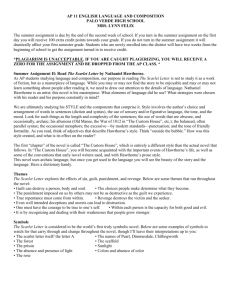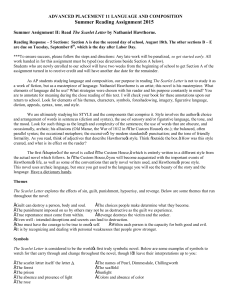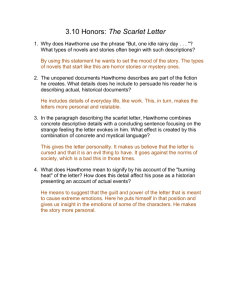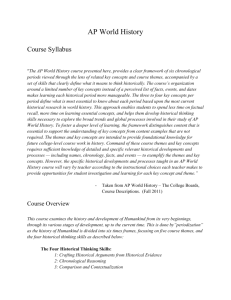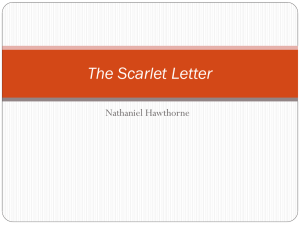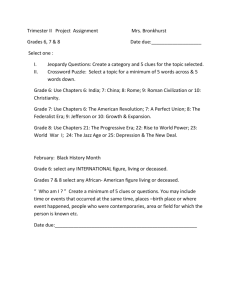AP ENGLISH LANGUAGE AND COMPOSITION SOUTHMOORE
advertisement
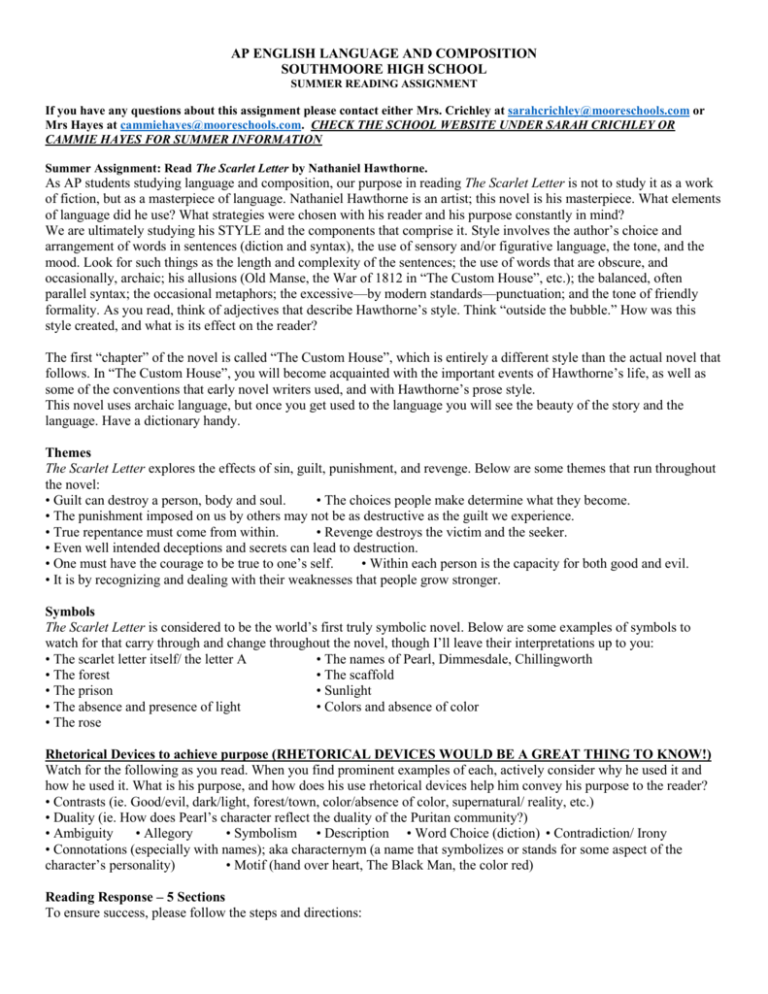
AP ENGLISH LANGUAGE AND COMPOSITION SOUTHMOORE HIGH SCHOOL SUMMER READING ASSIGNMENT If you have any questions about this assignment please contact either Mrs. Crichley at sarahcrichley@mooreschools.com or Mrs Hayes at cammiehayes@mooreschools.com. CHECK THE SCHOOL WEBSITE UNDER SARAH CRICHLEY OR CAMMIE HAYES FOR SUMMER INFORMATION Summer Assignment: Read The Scarlet Letter by Nathaniel Hawthorne. As AP students studying language and composition, our purpose in reading The Scarlet Letter is not to study it as a work of fiction, but as a masterpiece of language. Nathaniel Hawthorne is an artist; this novel is his masterpiece. What elements of language did he use? What strategies were chosen with his reader and his purpose constantly in mind? We are ultimately studying his STYLE and the components that comprise it. Style involves the author’s choice and arrangement of words in sentences (diction and syntax), the use of sensory and/or figurative language, the tone, and the mood. Look for such things as the length and complexity of the sentences; the use of words that are obscure, and occasionally, archaic; his allusions (Old Manse, the War of 1812 in “The Custom House”, etc.); the balanced, often parallel syntax; the occasional metaphors; the excessive—by modern standards—punctuation; and the tone of friendly formality. As you read, think of adjectives that describe Hawthorne’s style. Think “outside the bubble.” How was this style created, and what is its effect on the reader? The first “chapter” of the novel is called “The Custom House”, which is entirely a different style than the actual novel that follows. In “The Custom House”, you will become acquainted with the important events of Hawthorne’s life, as well as some of the conventions that early novel writers used, and with Hawthorne’s prose style. This novel uses archaic language, but once you get used to the language you will see the beauty of the story and the language. Have a dictionary handy. Themes The Scarlet Letter explores the effects of sin, guilt, punishment, and revenge. Below are some themes that run throughout the novel: • Guilt can destroy a person, body and soul. • The choices people make determine what they become. • The punishment imposed on us by others may not be as destructive as the guilt we experience. • True repentance must come from within. • Revenge destroys the victim and the seeker. • Even well intended deceptions and secrets can lead to destruction. • One must have the courage to be true to one’s self. • Within each person is the capacity for both good and evil. • It is by recognizing and dealing with their weaknesses that people grow stronger. Symbols The Scarlet Letter is considered to be the world’s first truly symbolic novel. Below are some examples of symbols to watch for that carry through and change throughout the novel, though I’ll leave their interpretations up to you: • The scarlet letter itself/ the letter A • The names of Pearl, Dimmesdale, Chillingworth • The forest • The scaffold • The prison • Sunlight • The absence and presence of light • Colors and absence of color • The rose Rhetorical Devices to achieve purpose (RHETORICAL DEVICES WOULD BE A GREAT THING TO KNOW!) Watch for the following as you read. When you find prominent examples of each, actively consider why he used it and how he used it. What is his purpose, and how does his use rhetorical devices help him convey his purpose to the reader? • Contrasts (ie. Good/evil, dark/light, forest/town, color/absence of color, supernatural/ reality, etc.) • Duality (ie. How does Pearl’s character reflect the duality of the Puritan community?) • Ambiguity • Allegory • Symbolism • Description • Word Choice (diction) • Contradiction/ Irony • Connotations (especially with names); aka characternym (a name that symbolizes or stands for some aspect of the character’s personality) • Motif (hand over heart, The Black Man, the color red) Reading Response – 5 Sections To ensure success, please follow the steps and directions: A. Journal Entries Section of your Reading Response Complete your journal entries section of your Reading Response in a Word document. You will have 10 journal entries to complete. Complete each log entry like the following: label the entry (Journal Entry 1, etc.) and respond to each log question(s) using commentary, analysis, insight, interpretation, etc. Skip a line. Then begin your next entry. Each entry must be a between 75 and 200 words. You might want to start the document at the beginning of the summer when you start reading the novel, and add to it as you read. Journal Entry 1: “The Custom House” “The Custom House” What is romanticism? What is the purpose of this chapter? How does Hawthorne’s family history contribute to his attitude toward The Custom House and his place in society? How would you describe Hawthorne’s attitude toward his former job and fellow workers? Why do you think so? (This is asking for TONE and evidence supporting your inference.) In this essay, Hawthorne addresses the reader directly. What effect does he create with this manner? What effect does the detailed description of the scarlet letter have on you? Journal Entry 2: Chapters 1-2 What is the narrator’s attitude toward the Puritans? What is his attitude toward Hester? Discuss themes, symbols, and rhetorical devices in these chapters (see above). Journal Entry 3: Chapters 3-4 How does the narrator present Chillingworth to the reader? Discuss themes, symbols, and rhetorical devices in these chapters (see above). Journal Entry 4: Chapters 5-6 What is the effect of the scarlet letter upon Hester? Describe Pearl’s character. Discuss themes, symbols, and rhetorical devices in these chapters (see above). Journal Entry 5: Chapters 7-8 Explain Hester’s argument concerning her rights to Pearl. Discuss themes, symbols, and rhetorical devices in these chapters (see above). Journal Entry 6: Chapters 9-12 What is Chillingworth’s project? What is Dimmesdale’s inner struggle, and how does it affect him? Discuss themes, symbols, and rhetorical devices in these chapters (see above). Journal Entry 7: Chapters 13-15 In what different ways can the scarlet letter be interpreted? What do these different ways reveal about Hester’s view of herself and her role in Puritan society? Discuss themes, symbols, and rhetorical devices in these chapters (see above). Journal Entry 8: Chapters 16-19 Explain the kind of love Hester and Dimmesdale have for each other. What prevents them from acting upon this love? Discuss themes, symbols, and rhetorical devices in these chapters (see above). Journal Entry 9: Chapters 20-22 Why does Dimmesdale finally announce his guilt? How does he do so – what type of language does he use, who does he address, and why? Discuss themes, symbols, and rhetorical devices in these chapters (see above). Journal Entry 10: Chapters 23-24 What is Hester’s role in society? What is her view of the role? Discuss themes, symbols, and rhetorical devices in these chapters (see above). B. Poetry Section of the Reading Response After you have read the book you must find one poem that relates and connects to the literature and include the author’s name. (You cannot make up a poem for this section.)You must provide a copy of the poem and write a paragraph in which you explain the connections and relationships between the literature and the poem. Again, as with all sections of your response, this is typed. C. Art Work Section of the Reading Response You must find and provide a copy of one piece of artwork that relates to The Scarlet Letter, and include the artists. This means actual artwork, not “clip art.” You must write a paragraph that explains the relationship and connection that the artwork has with the book. Again, as with all sections of your response, this is typed. *PLAGIARISM IS UNACCEPTABLE. IF YOU ARE CAUGHT PLAGERIZING, YOU WILL RECEIVE A ZERO FOR THE ASSIGNMENT.
